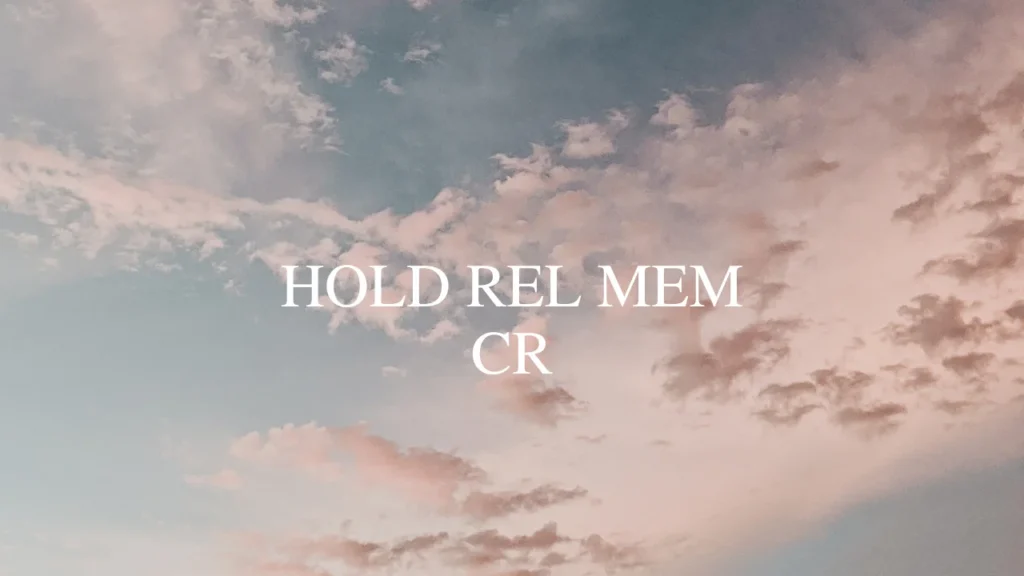Have you ever checked your bank account and noticed a mysterious “hold rel mem cr” entry? Maybe your funds were on hold, and you wondered why. It’s frustrating when money you expected to use is locked up. As someone who’s dealt with banking surprises, I get it. This article explains what “hold rel mem cr” means, why holds happen, and how to handle them. Whether you bank with Chase or another institution, you’ll find clear answers and practical tips to navigate these situations.
What Is Hold Rel Mem Cr?

“Hold rel mem cr” is a banking term that often appears in transaction records. It stands for “hold release memo credit.” It signals that a temporary hold on funds in your account has been lifted, making the money available again. Holds are common in banking, especially with deposits or pending transactions. Understanding this term helps you manage your finances without stress.
Why Holds Happen
Banks place holds to verify transactions or deposits. This ensures the funds are legitimate before you can spend them. For example, if you deposit a check, the bank may hold the funds until the check clears. This protects both you and the bank from fraud or bounced checks.
Hold Rel Mem Cr Meaning
When you see “hold rel mem cr,” it means the bank has released the hold. The funds are now available for use. This could happen after a check clears or a pending transaction is finalized. It’s a confirmation that your money is back in your control.
Common Scenarios for Holds
Holds often occur with check deposits, large transactions, or suspected fraud. If you deposit a check from an unfamiliar source, the bank might hold it for a few days. Similarly, a large purchase might trigger a temporary hold until the transaction is verified.
Chase Bank Specifics
At Chase, “hold rel mem cr” follows the same logic. Chase may place holds on deposits or transactions based on their policies. For instance, a check deposit might be held for 2–7 business days, depending on the amount and source. Knowing Chase’s rules can help you plan better.
Common Reasons for Bank Holds
| Reason | Description | Typical Duration |
| Check Deposit | Verifying check authenticity | 2–7 business days |
| Large Transaction | Confirming payment source | 1–3 business days |
| Suspected Fraud | Investigating unusual activity | Varies, up to 10 days |
| New Account | Extra scrutiny for new customers | 7–10 business days |
Why Is Money on Hold?
Seeing money on hold in your bank account can be confusing. Banks use holds to manage risk and ensure transactions are valid. Let’s break down the main reasons your funds might be unavailable and what you can do about it.
Check Deposit Delays
When you deposit a check, the bank may not make the funds available right away. This is because checks can bounce if the issuer lacks funds. Banks hold the money until they confirm the check is good. This usually takes a few days but can be longer for large or out-of-state checks.
Pending Transactions
Ever noticed a charge that’s “pending” in your account? That’s a hold. For example, when you swipe your card at a gas station, the station might place a hold for $100, even if you only spent $30. The hold ensures the merchant gets paid. Once the transaction clears, the hold is released.
Fraud Protection Measures
Banks monitor accounts for suspicious activity. If they spot something unusual—like a large purchase in a new location—they may place a hold. This protects you from unauthorized charges. However, it can tie up your funds until the bank investigates.
New Account Restrictions
If you’ve just opened a bank account, expect stricter hold policies. Banks often hold funds longer for new customers to establish trust. This is common with Chase and other major banks. After a few months, holds typically become less frequent.
In my experience, checking your bank’s hold policies when opening an account saves headaches later. Knowing what to expect helps you plan your spending.
How to Get a Hold Removed
Wondering how to remove a hold on your bank account? While some holds are unavoidable, you can take steps to speed up the process or avoid them altogether. Here are practical strategies to free up your funds.
Contact Your Bank
The fastest way to address a hold is to call your bank. For Chase customers, dial (800) 935-9935 or visit a branch. Explain the situation and ask why the hold was placed. Sometimes, providing additional details—like proof of a check’s source—can speed up the release.
Verify Transaction Details
If a hold is due to a pending transaction, confirm the details with the merchant. For example, a hotel might place a hold for incidental charges. Ask them to finalize the transaction, which can prompt the bank to release the hold sooner.
Provide Documentation
For check deposits, holds often stem from verification issues. If you have documentation, like a pay stub or contract, share it with the bank. This can reassure them the funds are legitimate, reducing the hold time.
Switch to Direct Deposits
Direct deposits, like paychecks, typically clear faster than checks. If you frequently face holds, ask your employer to switch to direct deposit. This minimizes delays and ensures quicker access to your money.
Monitor Your Account
Regularly check your account for holds or pending transactions. Use your bank’s mobile app to stay on top of activity. Catching holds early lets you act quickly, whether by calling the bank or resolving issues with a merchant.
Steps to Remove a Bank Hold
| Step | Action | Expected Outcome |
| Call Bank | Contact customer service | Clarify hold reason |
| Verify with Merchant | Confirm transaction details | Faster hold release |
| Provide Documents | Submit proof of funds | Reduced hold time |
| Use Direct Deposit | Switch to electronic payments | Fewer holds |
Here’s a tip I always give beginners: Set up account alerts to get notified of holds instantly. It’s a game-changer for staying in control.
Chase Bank Hold Policies
Chase Bank, one of the largest U.S. banks, has specific policies for holds. Understanding these can help you avoid surprises and manage your funds better. Let’s explore how Chase handles holds and what “hold rel mem cr” means in their system.
Check Deposit Holds
Chase typically holds check deposits for 2–7 business days. The duration depends on the check’s amount, source, and your account history. For example, a local check under $5,000 might clear in 2 days, while an out-of-state check could take longer.
Pending Transaction Holds
When you make a purchase, Chase may place a temporary hold until the transaction is finalized. For instance, a restaurant might hold an extra 20% for tips. Once the final amount is processed, the hold is released, and you’ll see “hold rel mem cr” in your account.
Fraud-Related Holds
Chase uses advanced monitoring to detect fraud. If they flag a transaction—like a large overseas purchase—they may hold the funds. You’ll need to verify the transaction by calling or visiting a branch. Once cleared, the hold is lifted.
New Account Holds
New Chase accounts face stricter hold policies. Deposits may be held for up to 10 business days to ensure legitimacy. As you build a relationship with Chase, these holds become less common. Regular deposits and a clean account history help.
What I learned the hard way is: Always ask Chase about hold policies when depositing large checks. It prevents unexpected delays.
Common Hold-Related Issues
Holds can lead to confusion or financial hiccups. Let’s look at frequent issues, like returned deposits or unexpected charges, and how to handle them.
Deposited Item Returned
A “deposited item returned” notice means a check you deposited didn’t clear. This could be due to insufficient funds in the issuer’s account or a stop payment. Chase will deduct the amount from your account and may place a hold on future deposits from the same source.
Hold Rel Mem Cr Charges
Some wonder if “hold rel mem cr” involves charges. Typically, it doesn’t. It’s just a notification of a hold release. However, if a hold is due to a returned check, you might face a fee (e.g., $12–$34 at Chase). Check your account agreement for details.
Funds Available Confusion
You might see “hold rel mem cr” but still can’t access funds. This happens if another hold is in place or the transaction hasn’t fully cleared. Check your account or call Chase to confirm all holds are lifted.
Reddit Discussions
On Reddit, users often share experiences with “hold rel mem cr Chase Bank meaning.” Common themes include frustration with long hold times and confusion over pending transactions. Reading these threads can offer insights, but always verify with Chase for accurate info.
Common Hold Issues and Solutions
| Issue | Cause | Solution |
| Returned Deposit | Check bounced | Verify issuer’s funds |
| Unexpected Charges | Fees for returned items | Review account terms |
| Funds Still Held | Multiple holds | Contact bank |
| Confusion Over Terms | Unclear bank jargon | Ask for clarification |
Actionable Tips to Manage Holds
Dealing with bank holds doesn’t have to be stressful. Here are five actionable tips to help you stay ahead:
- Check Hold Policies: Before depositing checks, ask your bank about their hold times. This helps you plan your finances better.
- Use Mobile Alerts: Set up notifications for holds or low balances. Chase’s app lets you track account activity in real time.
- Communicate with Merchants: If a pending transaction causes a hold, ask the merchant to finalize it quickly. This speeds up the release.
- Keep Documentation: Have proof of funds, like pay stubs, ready for large deposits. It can reduce hold times.
- Build Account History: Maintain a clean account with regular deposits. Banks often relax holds for trusted customers.
FAQs About Hold Rel Mem Cr
What does hold rel mem cr mean for Chase?
It’s a notice that Chase has released a hold on your funds, making them available. It often follows a check deposit or pending transaction.
How long do holds last at Chase?
Holds typically last 2–7 business days for check deposits and 1–3 days for pending transactions. Fraud-related holds may take longer.
Why is my money on hold?
Your money might be on hold due to a check deposit, pending transaction, fraud concerns, or new account restrictions.
How do I remove a hold on my account?
Call Chase, verify transaction details, or provide documentation. Using direct deposits can also prevent future holds.
What is a deposited item returned?
It means a check you deposited didn’t clear, often due to insufficient funds. Chase may deduct the amount and charge a fee.
Are there charges for hold rel mem cr?
Usually, no. But returned checks or overdrafts tied to holds may incur fees. Check your account terms.
Read More: Meet TheWeeklySpooncom: Top Food Blog
Conclusion
Navigating “hold rel mem cr” and bank holds can feel overwhelming, but it doesn’t have to be. By understanding why holds happen, how to remove them, and Chase’s policies, you can take control of your finances. Use the tips shared—like checking policies and setting alerts—to avoid surprises. Whether it’s a check deposit or a pending transaction, you now know how to handle holds with confidence. Keep monitoring your account, and don’t hesitate to contact your bank for clarity.




